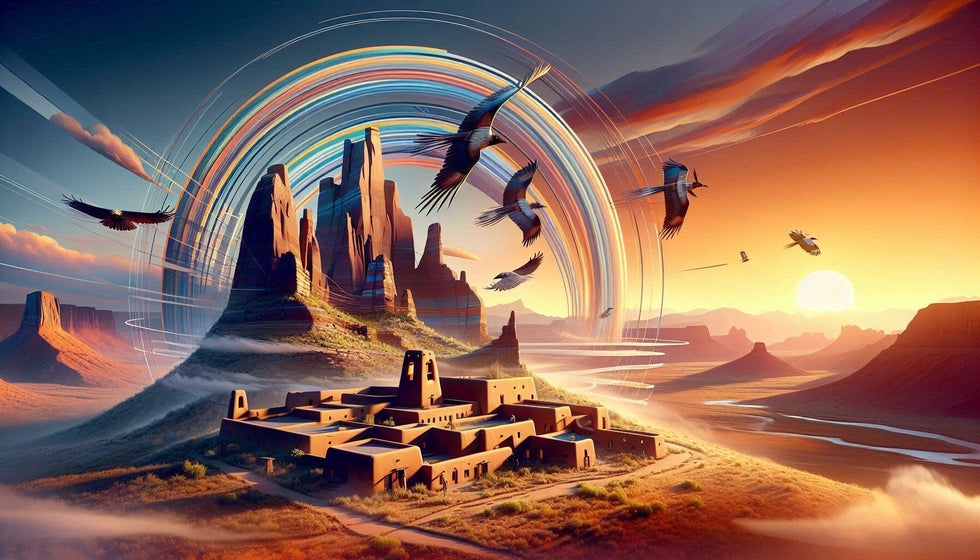
THE PUEBLOANS
The Pueblo peoples, also known as the Puebloans, are Native Americans in the Southwestern United States who share common agricultural, material, and religious practices1.
-
Historical Background: The Pueblo Native Americans are one of the oldest cultures in the United States, originating approximately 7,000 years ago2. They are thought to be the descendants of the prehistoric Ancestral Pueblo (Anasazi) culture
-
Cultural Diversity: Just as there was considerable regional diversity among the Ancestral Puebloans, there is similar diversity, both cultural and linguistic, among the contemporary Pueblo peoples3.
-
Geographical Spread: Representative of the Southwest Indian culture area, most Pueblo peoples live in northeastern Arizona and northwestern New Mexico3. They originally settled in the Mesa Verde region at the Four Corners of Colorado, New Mexico, Utah, and Arizona2.
-
Population: Early 21st-century population estimates indicated approximately 75,000 individuals of Pueblo descent3.
-
Languages: The eastern Pueblo villages speak Tanoan and Keresan languages, while the western Pueblo villages include the Hopi villages of northern Arizona and the Zuni, Acoma, and Laguna villages, all in western New Mexico3.
-
Political Structure: Each of the 70 or more Pueblo villages extant before Spanish colonization was politically autonomous, governed by a council composed of the heads of religious societies3.
-
Agriculture: Traditionally, Pueblo peoples were farmers, with the types of farming and associated traditions of property ownership varying among the groups3.
The Pueblo peoples are one of the oldest cultures in the United States, with a history that spans approximately 7,000 years. They are thought to have descended from three ancient cultures: the Mogollon, Hohokam, and Ancestral Puebloans, also known as the Anasazi1.
The Ancestral Puebloans were known for their remarkable cliff dwellings and intricate pottery. They settled in the Mesa Verde region at the Four Corners of Colorado, New Mexico, Utah, and Arizona. Over time, due to limited natural resources or intertribal conflict, the Pueblo people migrated south and primarily settled in northeastern Arizona and northwestern New Mexico1.
The arrival of the Spanish in the 15th century brought significant challenges to the Pueblo tribes. Spanish colonization imposed censorship of Pueblo culture and religious practices. However, by the 1670s, the Pueblo revolts forced the Spanish to flee, allowing the Pueblo people to return to their long-standing cultural practices1.
Today, the Pueblo peoples are known for living in compact permanent settlements known as pueblos and are representative of the Southwest Indian culture area. There is considerable diversity among the contemporary Pueblo peoples, both culturally and linguistically, with communities speaking Tanoan, Keresan, Zuni, and Uto-Aztecan languages2.
Each Pueblo village was historically autonomous, governed by a council composed of the heads of religious societies. These societies were centered in the kivas, which are subterranean ceremonial chambers that also served as private clubs and lounging rooms for men. Traditionally, Pueblo peoples were farmers, with women doing most of the farming while men also became responsible for agricultural work as hunting diminished in importance2.
The Pueblo peoples’ resilience and ability to adapt to changing environments and circumstances have allowed them to preserve their rich heritage and continue their traditions into the present day. Their story is a testament to the enduring spirit of the Pueblo Nation.
Here’s a glimpse into a typical day in the life of a Puebloan:
The sun had barely risen over the horizon, casting long shadows over the Puebloan village nestled in the heart of the Southwestern United States1. The air was filled with the scent of maize, the staple crop of the Puebloans, being prepared for the morning meal1.
In one of the adobe houses, a Puebloan named Tawa woke up to the sound of the village coming to life. He stepped out of his house, built of carefully shaped stones2, and looked out at the terraced farms that stretched out before him3. These farms were a testament to the Puebloans’ meticulous agricultural practices, which required extensive planning, cooperation, and labor3.
Tawa spent his morning tending to the crops, utilizing the terraced farming techniques to maximize the use of arable land and prevent soil erosion3. The Puebloans had developed a set of religious beliefs that emphasized the sacred importance of rain and concentrated an annual cycle of religious ritual on rain making4.
After a long morning in the fields, Tawa returned home for the midday meal. The Puebloans were skilled potters, and Tawa ate from a bowl that he had crafted himself5. The afternoon was spent repairing tools and trading goods with his neighbors5.
As the sun began to set, Tawa joined the other villagers in the central plaza for the evening’s festivities. They shared stories, danced, and celebrated their community’s harmony with nature1.
This was a typical day for Tawa and his fellow Puebloans, a day marked by hard work, community, and a deep respect for the land that sustained them1. Their lives may have been simple by today’s standards, but they were rich in tradition, culture, and a sense of belonging1.


Add comment
Comments
THE PUEBLO NATION....GREAT TOPIC for the Virtual Creative Factory in COLORADO.!!!